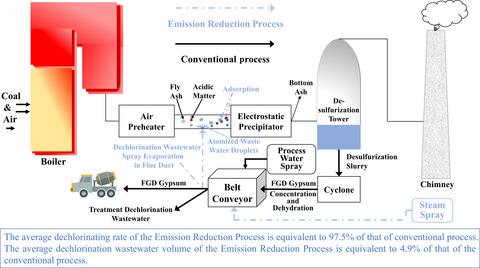当前位置:
X-MOL 学术
›
Energy Sci. Eng.
›
论文详情
Our official English website, www.x-mol.net, welcomes your
feedback! (Note: you will need to create a separate account there.)
Emission reduction process for dechlorinating flue‐gas desulfurization gypsum and reducing wastewater effluents: Application prospects from laboratory‐scale studies
Energy Science & Engineering ( IF 3.5 ) Pub Date : 2020-06-20 , DOI: 10.1002/ese3.666 Shaojie Chen 1 , Tianqi Jiang 1 , Huawei Zhang 2 , Kai Kong 1, 3 , Longshuai Bie 4
Energy Science & Engineering ( IF 3.5 ) Pub Date : 2020-06-20 , DOI: 10.1002/ese3.666 Shaojie Chen 1 , Tianqi Jiang 1 , Huawei Zhang 2 , Kai Kong 1, 3 , Longshuai Bie 4
Affiliation

|
The treatment of flue‐gas desulfurization (FGD) gypsum, a common solid waste material that is often affected by chloride ions, typically occupies large amounts of land, causes resource waste, and results in environmental pollution. An emission reduction process involving the dechlorination of FGD gypsum and reducing its emissions has been proposed to solve these problems. Laboratory experiments were conducted to verify the feasibility of the emission reduction process and study any differences from the conventional process. The test results indicated that the average dechlorination rate of the emission reduction process was 80.4%, which is equivalent to 97.5% of the conventional process. The average dechlorination wastewater volume of the emission reduction process was 0.22 L, which is equivalent to 4.9% of the conventional process. The results show that the emission reduction process can effectively reduce the chlorine content of FGD gypsum and its related wastewater discharge. This novel gypsum dechlorination process effectively reduces the chlorine content of FGD gypsum and related wastewater. In addition, the emission reduction process can lead to greater recovery of renewable resources and can result in a cleaner energy conversion process. This process is an alternative method for recovering residues and resources without secondary pollution. Therefore, if this technology is integrated into existing FGD facilities, costly chemical processes could be replaced by those that recover a renewable resource and incorporate a clean energy conversion process.
中文翻译:

烟气脱硫石膏脱氯和减少废水排放的减排过程:实验室规模研究的应用前景
烟气脱硫石膏(FGD)的处理是一种常见的固体废物,经常受到氯离子的影响,通常占用大量土地,造成资源浪费,并造成环境污染。为了解决这些问题,已经提出了一种涉及烟气脱硫石膏脱氯并减少其排放的减排方法。进行了实验室实验,以验证减排过程的可行性,并研究与常规过程的任何差异。测试结果表明,减排工艺的平均脱氯率为80.4%,相当于常规工艺的97.5%。减排过程的平均脱氯废水量为0.22 L,相当于常规过程的4.9%。结果表明,减排工艺可以有效降低烟气脱硫石膏的氯含量及其相关废水排放。这种新颖的石膏脱氯工艺可有效降低烟气脱硫石膏和相关废水中的氯含量。另外,减少排放的过程可以导致可再生资源的更大回收,并且可以导致更清洁的能量转换过程。此过程是在不造成二次污染的情况下回收残留物和资源的另一种方法。因此,如果将此技术集成到现有的烟气脱硫设施中,则可以用回收可再生资源并结合清洁能源转化过程的化学过程代替昂贵的化学过程。
更新日期:2020-06-20
中文翻译:

烟气脱硫石膏脱氯和减少废水排放的减排过程:实验室规模研究的应用前景
烟气脱硫石膏(FGD)的处理是一种常见的固体废物,经常受到氯离子的影响,通常占用大量土地,造成资源浪费,并造成环境污染。为了解决这些问题,已经提出了一种涉及烟气脱硫石膏脱氯并减少其排放的减排方法。进行了实验室实验,以验证减排过程的可行性,并研究与常规过程的任何差异。测试结果表明,减排工艺的平均脱氯率为80.4%,相当于常规工艺的97.5%。减排过程的平均脱氯废水量为0.22 L,相当于常规过程的4.9%。结果表明,减排工艺可以有效降低烟气脱硫石膏的氯含量及其相关废水排放。这种新颖的石膏脱氯工艺可有效降低烟气脱硫石膏和相关废水中的氯含量。另外,减少排放的过程可以导致可再生资源的更大回收,并且可以导致更清洁的能量转换过程。此过程是在不造成二次污染的情况下回收残留物和资源的另一种方法。因此,如果将此技术集成到现有的烟气脱硫设施中,则可以用回收可再生资源并结合清洁能源转化过程的化学过程代替昂贵的化学过程。











































 京公网安备 11010802027423号
京公网安备 11010802027423号